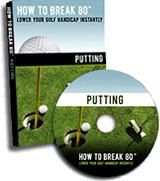|
How To Stop Coming Over The Top
By Jack Moorehouse
We've all done it at least once. Coming over the top is an all too common problem among players with high golf handicaps. In fact, it's one of the biggest faults I encounter with players who come to me for golf lessons. For some weekend golfers, however, coming over the top is more than just an occasional mistake. It's a chronic problem. But it doesn't have to be.
Swinging over the top delivers the clubhead from the top of the swing to impact on a path outside the target line and at an approach too steep to produce the desired ball flight. The result: a shot pulled into the left woods, a pull hook out of bounds, a weak pop-up that travels about 30 yards, or a weak slice to the right. The first thing you need to do, as I've mentioned in my golf tips, is finding what causes the problem.
The Causes
It's not hard to spot the causes of this swing fault. They usually fall into four categories:
1. Incorrect pre-swing preparation
2. Mentally induced problems
3. Body-related problems
4. Club-related problems
Most of these problems are related in one way or another. Incorrect use of the body can cause the club to get out of position. The wrong mental approach can cause your body to work the wrong way. While a poor setup can cause all these problems.
Overcoming the Problem
The ultimate goal is to return the clubhead to the ball on a path inside the backswing path, have it travel along the target line, then swing inside or left of the line during the follow through. That's the ideal. It's what we should aim for almost every time we take a full swing.
Two concepts will help us overcome the problem: (1) keep the base of your spine closer to the target than the top of your spine on all full shots at address and throughout the swing, and (2) swing your arms freely, both going back and coming through, so your body does not unduly influence them.
Mentally Induced Errors
Two thoughts are particularly detrimental to developing a good golf swing. One is that power and effort are required to hit the ball long distances. The other is that the swing path should be inside out, from inside the target line coming down to outside it on the follow-through. Both thoughts can cause you to come over the top.
Curing mentally induced faults is accomplished by correctly blending the swing's vertical, rotary, and lateral aspects. Swinging the arms freely, virtually independently of the shoulders, while the legs hips and lower torso turn to allow the club to get on the correctly plane, helps eliminate the problem. The Baseball Drill, in which you swing the club like a baseball bat, encourages you to swing the club freely.
Setup Problems
The correct setup is vital to swinging from the inside. The setup pitfalls that cause you to swing over the top fall into four categories—grip, ball position, posture, and aim and bodylines. Some players who take golf lessons from me commit all four errors at once or a combination of them the simultaneously.
Check your set up for the following: Make sure your grip is not too weak, your ball position not too far left, and your right shoulder not too high, causing the top of your spine to be too close to the target. Also, check your aim in relation to your bodylines. The bodylines—eyes, shoulders, hips knees, and feet—get twisted in relation to each other and the target line. Place a long rope on the ground toward the target, directly along the target line. Use it to align all your body angles.
Shaft Line Problem
Among the major causes of coming over the top is getting the club too far behind the shaft on the downswing, which can cause the hands get separated from the body starting back. But it's easily corrected with this drill I use in golf instruction sessions. Place a clubshaft against the ball of your right foot (left foot for left-handers) Swing back to hip high. Keep the clubhead outside the hands. Your clubhead should be directly over and parallel to the clubshaft on the ground.
Incorrect Turning
To swing your arms back freely back and up and then down again, you must turn correctly. That blends the vertical, lateral, and rotary movements of your swing. Turing problems fall into two categories: (1) under turning of the hips, and (2) swaying to the right (left for left-handers). In practice, work on preventing these errors by turning the right hip off line while swinging the club up with the arms, which get the shoulders, upper torso, and shoulders fully turned. Practicing the Shaft, the Broom Handle, and the Front-loader drills, which I've described before in my golf tips, improve turning.
Coming over the top is among the weekend golfer's most common swing faults. It usually provides some grim results. For some, it's a chronic problem. If that's you' you don't have to be plagued by this fault forever. Isolate what's causing the problem based on the information in this article. Then work on correcting it. Through practice you'll eliminate the problem and cut strokes from your scores. The final result: a lower golf handicap.
Jack
Moorehouse is the author of the best-selling book "How
To Break 80 And Shoot Like The Pros." He is NOT a golf pro, rather a
working man that has helped thousands of golfers from all seven continents lower
their handicap immediately. He has a free weekly newsletter with the latest
golf tips, golf lessons and
golf instruction.
|
Tools To
Help Your Game!

eBook

Physical Book

Audio Program

Short Game DVD

Driver DVD

Putting DVD
|